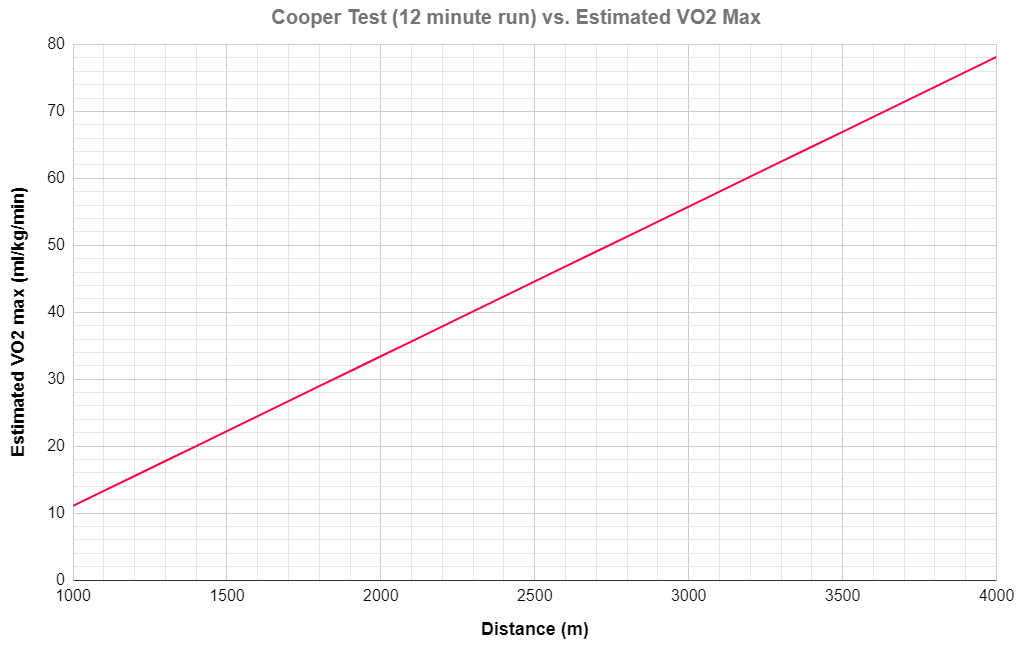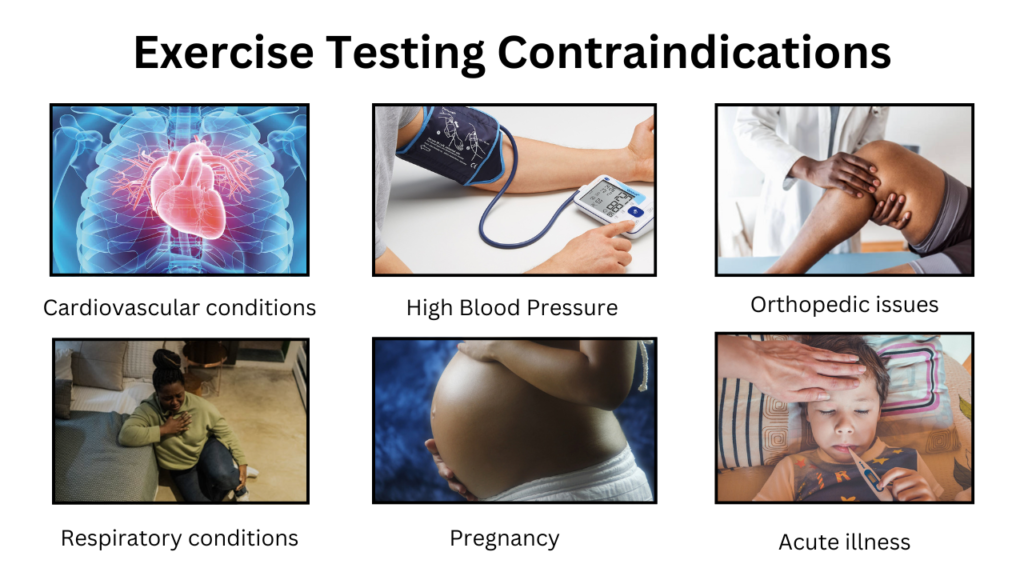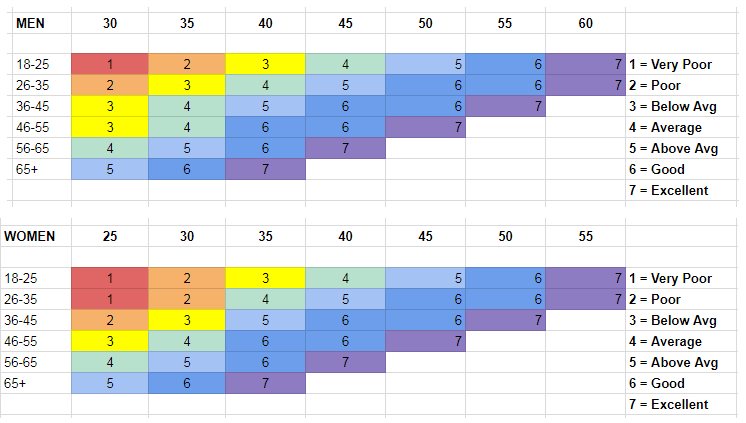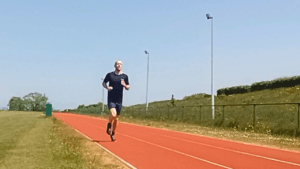VO2 max is a measure of the maximal volume of oxygen your body can use and it’s a good indicator of cardiovascular fitness. A true VO2 max test is conducted in a lab and involves exercising to failure while wearing a mask.
However, there are simple tests that can provide an estimate of your VO2 max. I’ve previously covered the Queen’s College step test, and the Rockport Walking Test. Both of those are sub-maximal tests, a popular option for maximal testing is the Cooper Test.
What is The Cooper Test
The Cooper Test was developed in 1968 [1] as a way to assess maximal oxygen intake (VO2 max). Distance run in 12 minutes was compared to a treadmill VO2 max test, with a correlation of r = 0.897. In practice that means if you had a true VO2 max of 50 ml/kg/min the Cooper Test is likely to result in a score between 44 and 56 ml/kg/min.

How To Do The Cooper Test
The Cooper Test is also known as the “12 minute run” test, and that’s exactly what’s required of you. Following a thorough warm up, the aim of the test is to run as far as you can in exactly 12 minutes. For the highest level of accuracy, it’s best to conduct this test on an athletics track. This provides a consistent, flat surface and the ability to measure an exact distance.
For a less desirable alternative, you could run 12 minutes in a relatively flat area and use your mobile phone’s GPS or a map to determine the distance you covered. With this alternative method the margin of error in your estimated VO2 max will be much higher.

If you are using an athletics track, start the test at the 400m finish line in lane 1. Note the number of complete laps and then measure the remaining distance for your incomplete lap. For example, 6 complete laps and an additional 150 metres would be 6 x 400m + 150m = 2550 metres.
How To Pace Yourself For The Cooper Test
One drawback of the Cooper Test is knowing how to pace yourself. If you don’t regularly run then you may have no idea how fast you should set off. A workaround is to complete a submaximal estimated VO2 max test and use that result to determine a theoretical distance you could achieve.
If you first completed the Rockport Walking Test you would have an estimate of your VO2 max. By looking up the distance you’d need to cover in the Cooper Test to achieve the same score, you have a reasonable starting estimate. Alternatively, make a fair estimate of your expected fitness level and find the appropriate distance.
Estimated VO2 max = (distance run in metres – 504.9) ÷ 44.73
Cooper 1968
Or put another way, Estimated Distance = (VO2 max * 44.73) + 504.9.
Use the above equations to calculate your estimated VO2 max based on the distance covered, or vice versa. There is also a reference graph below for distances between 1000 and 4000 metres.

Using myself as an example:
- My estimated VO2 max from the Rockport Walking Test was 51.8 ml/kg/min.
- Finding 51.8 on the y axis of the graph above equates to roughly 2800m on the x axis.
- If I plug it into the equation (VO2 max * 44.73) + 504.9, I get (51.8 * 44.73) + 504.9 = ~2822 metres.
You might note that the multiplier 44.73 means that every additional 44.73 metres you cover in the test is equivalent to +1 ml/kg/min in VO2 max. That also gives you an idea of how variable your result might be if you chose to test using a map or GPS tracker.
Contraindications
Before you go out and run, there are certain individuals for whom exercise testing is contraindicative. Below are the most common conditions that may prevent you from safely completing this test.

As this is a maximum effort test, it’s worth speaking to your doctor if you’re in any doubt whether this test is safe for you to do.
What do my results mean
Your results are best compared relative to others of the same age and sex. Below is a set of normative data for VO2 max for both men and women. What constitutes “average” can vary between research studies due to the population samples they use.

At the top end, elite athletes average 55-65 ml/kg/min with endurance specialists able to reach 75-85 ml/kg/min. Cross Country Skiers are often touted as the athletes who score the highest, with some managing to score 90-95 ml/kg/min on their VO2 max tests.
At the lower end of the scale, an unfit 65 year old may start dipping under 20 ml/kg/min. This would mean walking uphill would be right at the limit of their capabilities. A VO2 max this low may start to infringe on other activities of daily living.
Tracking VO2 max over time
There is a very well established decline in VO2 max with age, and that happens regardless of fitness level. The difference is that a fitter individual will remain at a higher level relative to the unfit individual as they both age.
While it’s a relatively intense test to take, completing it once a year will help you track fitness over time. People typically lose 1% of their VO2 max a year, so even if you maintain your activity levels, you will see a decline with age. Here I’ve included my results, which come from a range of different tests including maximal tests like the Cooper Test, Bleep Test and 2000m row.

One important point to remember about a maximal test is that it requires a much higher degree of motivation. I’m confident that explains the difference between the red and black lines above.
In my latest Cooper Test I ran 2806 metres for a score of 51.5 ml/kg/min. If I made it to 2920 metres it would match the estimated VO2 max of 54.0 ml/kg/min that I was predicted based on sub-maximal tests. While I collapsed to the floor at the end of the 12 minutes, I believe I could have gone 4% further if I was pushing the absolute limit of my ability.
It may be worth taking a submaximal test as well and comparing results.
[1] A means of assessing maximal oxygen intake. Correlation between field and treadmill testing. Cooper 1968.

